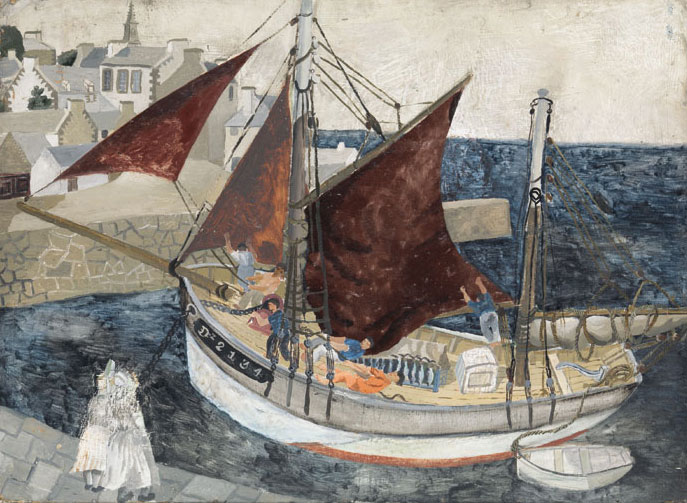Ut pictura poesis, Horace wrote sometime around the year 19 BC: as is painting, so is poetry. Few ideas have had longer careers in the history of aesthetics than this dictum. It has inspired much elaboration and also much disagreement; the Earl of Shaftesbury huffed and puffed, in his unfinished treatise of 1712, Plastics, to say that ‘comparisons and parallels between painting and poetry’ are ‘almost ever absurd and at best lame, constrained and defective’. He did little to slow such comparisons down.
The parallel between painting and poetry has also encouraged close relations between the two arts. A very small number of people have achieved great things in both (Michelangelo, William Blake, David Jones), but many more have mastered one art while aspiring to the condition of the other. Since poetry, which takes place in language, is a fundamentally temporal art, and painting, which takes place in form and colour, is a fundamentally spatial one, interesting things happen when they collide.
Self-portrait (1927), Christopher Wood. Kettle’s Yard, University of Cambridge

Not many figurative painters are as often described as ‘lyrical’ as the Englishman Christopher Wood (1901–30), known to his friends as Kit Wood, who is the subject of a major exhibition at Pallant House Gallery in Chichester this summer (2 July–2 October). A 2004 exhibition at the Graves Gallery in Sheffield went so far as to call itself ‘Christopher Wood: Between Poetry and Art’. It is obvious what is roughly meant by the description ‘lyrical’ or ‘poetic’: it speaks of the freshness and spontaneity in Wood’s vision, the joyful openness to sea air, first in Cornwall, then Brittany, and the enraptured, almost childish intensity of emotion and perception that comes from his best paintings.
These qualities, perhaps combined with the romantic glamour of his short life and tragically early death (bisexuality, opium, train tracks), have made Wood an attractive figure to several notable modern poets. When the Northern Irish poet Paul Muldoon’s second book, Mules, was being prepared for publication in 1976, he wished to have Wood’s Zebra and Parachute (1930) on the cover. This painting, made in the last month of Wood’s life, finds a zebra surreally standing on the roof terrace of Le Corbusier’s Villa Savoye near Paris, while above a slumped airman falls to earth on his parachute. Muldoon’s publisher shortsightedly refused his choice of cover image, but it would have made a witty companion to the implications of his title. Mules, the offspring of donkeys and horses, are Muldoon’s metaphor for how multiple meanings can exist in one creation; Wood’s painting is just such a crossbreed between surrealism, the cool abstraction of the architecture, and more traditional painterly values.
In the same year, a different approach to Wood’s work was taken by John James in his poem ‘After Christopher Wood’ (1976):
it would be ordinary enough to live
in a room that balanced above
the sea’s implied presence,
a soft draught of light taken in
by the half-open lips of pale green shutters […]
John James lived for many years in Cambridge, and the poem is perhaps inspired by time spent with the large collection of Wood’s paintings at Kettle’s Yard. It determinedly avoids ekphrasis, instead distilling the atmosphere of Wood’s Cornish and Breton lyricism and his erotic languor into poetic images, without tying them to details from any of his paintings in particular.
Boat in Harbour, Brittany (1929), Christopher Wood. Tate Collection

In 1997, the Scottish artist and concrete poet Ian Hamilton Finlay produced an artist’s book, Painting by Numbers: A Homage to Christopher Wood, which reduces 11 of Wood’s maritime paintings to a playfully austere abstraction. The page for Boat in Harbour, Brittany (1929), for instance, bears nothing but the title of the painting and the characters ‘DZ 2134’. This, and other initially baffling strings of letters and numbers, turn out on closer inspection to be the port codes and registration numbers of the fishing boats pictured in Wood’s paintings. Extracting these codes from Wood’s paintings seems at first to turn them into something cold and formalistic, but subsequently to reinscribe the reality of the livelihoods and practicalities at stake in these coastal scenes, and to summon up a sort of melancholy poetry of the kind associated, in the British Isles, with the daily broadcast of the Shipping Forecast.
The modern poem that addresses a painting by Wood most directly is ‘The Jumping Boy’ by Geoffrey Hill, first published in 2006, which takes its title from Wood’s late painting The Jumping Boy, Arundel, West Sussex (1929):
Here is the jumping boy, the boy
who jumps as I speak […]
He leaps because he has serious
joy in leaping […] He is winning a
momentous and just war
with gravity.
As Hill has explained, his poem combines elements of ekphrastic description of Wood’s painting with elements of private memory, recalling the poet as he was pictured in a cherished photograph, winning the high jump at his school sports day in around 1940. The jumping boy becomes an emblem for creativity, as he launches himself against the resistant medium of the air. The poet both redirects and transforms the energy frozen on the canvas, with its boy caught in mid-air, to propel poetic language across the improvised hurdles of his line-endings: ‘Jump away, jumping boy; the boy I was / shouts go.’
The Jumping Boy, Arundel, West Sussex (1929), Christopher Wood. Museums Sheffield

Whether Shaftesbury was right to call parallels between painting and poetry ‘lame, constrained and defective’, or whether Horace’s ut pictura poesis holds firm after more than 2,000 years, the exhibition of Wood’s work at Pallant House will provide a rich testing ground for the nature and extent of the likenesses between the two arts.
‘Christopher Wood: Sophisticated Primitive’ is at Pallant House Gallery, Chichester, from 2 July–2 October.
From the July/August issue of Apollo: preview and subscribe here.


